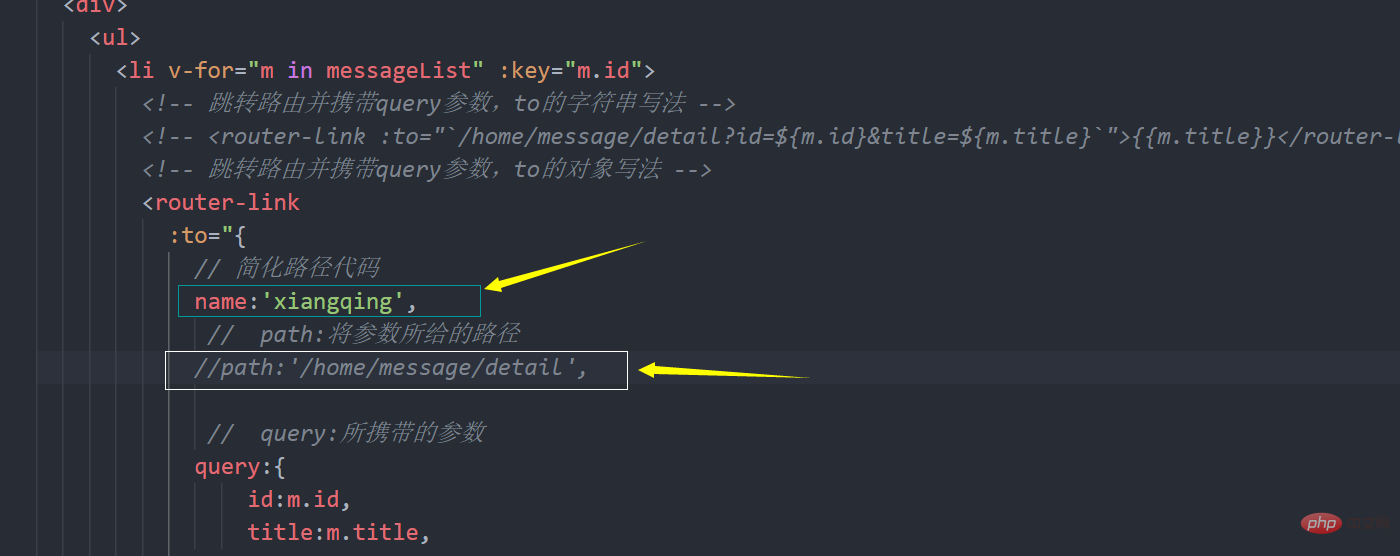An article briefly analyzing routing and various guards in Vue
This article will give you a detailed explanation of routing in Vue and guard these two knowledge points. Friends can conduct related studies based on the content of the article

1.vue-router
A plug-in library for vue, specially used to implement single-server support for SPA applications Single page web application (SPA). There is only one complete page for the entire application. Clicking a navigation link in the page will not refresh the page, but will only partially update the page. Data needs to be obtained through ajax request.
2. What is routing
-
A route is a set of mapping relationships (key: value)
key is the path, value may be function or component
Routing classification
1. Backend routing: value function, used to process requests submitted by the client. Working process: When the server receives a request, it finds the matching function according to the request path to process the request and returns the response data. [Related recommendations: vuejs video tutorial, web front-end development]
2. Front-end routing: value is component, used to display page content . Working process: When the browser path changes, the corresponding component will be displayed.
3. Basic use of routing
1.Install vue-router
npm i vue-router
2.Apply plug-in
Vue.use(VueRouter)
3. Router configuration items
// 引入vueRouter
importvueRouterfrom'vue-router'
// 引入组件
importAboutfrom'../components/About'
importHomefrom'../components/Home'
export default new vueRouter({
routes: [{
path: '/about',
component: About
},
{
path: '/home',
component: Home
},
]})
4. Use router-link to switch (Note: router-link will become a tag after passing through the browser)
<divclass="list-group">
<!-- 原始写法——使用a标签进行页面的跳转 -->
<!-- <a class="list-group-item active" href="./about.html">About</a>
<a class="list-group-item" href="./home.html">Home</a>-->
<!-- 使用vue-Router提供的标签进行路径的修改,实现路由的切换 -->
<router-link
class="list-group-item"
active-class="active"
to="/about">About
</router-link>
<router-link
class="list-group-item"
active-class="active"
to="/home">Home
</router-link>
</div>5. Use router-view to implement component presentation (similar to slots)
<divclass="panel-body">
<!-- 指定组件的呈现位置 -->
<router-view>
</router-view>
</div>Note: 1. Routing components are usually stored in the pages folder, so do not go to the components folder Put it
2. By switching, the "hidden" routing component is destroyed by default, and can be mounted when needed
3. Each component has its own $route attribute, which is stored with its own routing information.
4. There is only one router in the entire application, which can be obtained through the $router property of the component.
4. Multi-level routing
Configure the next level routing in the routing rules and routing. Use children: [ { } ] This form
routes: [{
path: '/about',
component: About
},
{
path: '/home',
component: Home,
children: [{
path: 'news',
component: News
},
{
path: 'message',
component: Message
}
]
},
]5. Routing parameters
There are two ways. The first is to write the query parameters directly in the path. The second is to pass params
Route naming (simplified code)

You don’t have to write a lot when you go to The path is

##1.params
1. Configure the routing statement to accept params parameters children:[
{
name:'xiangqing',
path:'detail/:id/:title',// 使用占位符声明接收参数
component:Detail,
}
]<!-- 跳转路由并携带params参数,to的字符串写法 -->
<router-link:to="`/home/message/detail/${m.id}/${m.title}`">{{m.title}}</router-link>
<!-- 跳转路由并携带params参数,to的对象写法 -->
<router-link
:to="{
// 简化路径代码
name:'xiangqing',// 必须使用name,不能使用path
// params:所携带的参数
params:{
id:m.id,
title:m.title,
}
}"
>{{m.title}}</router-link> <div>
<ul>
<!-- params写法 -->
<li>消息:{{$route.params.id}}</li>
<li>编号:{{$route.params.title}}</li>
</ul>
</div>2. Routing props configuration
in total There are three configuration methods, namelyObject type, Boolean type, Functional typeThe purpose is to make the routing component more convenient to receive parameters
children: [{
name: 'xiangqing',
// path: 'detail/:id/:title', // 使用占位符声明接收参数
path: 'detail', // query不使用占位符声明接收参数
component: Detail,
// props的第一种写法
// props:{a:"1",b:"2"},
// 第二种写法,值为布尔值,若布尔值为真,就会把该路由组件收到的所有params參数,以props的形式传给Detail
// props:true,
// props的第三种写法,值为函数
props($route) {// 使用解构赋值连续写法简化代码
return {id:$route.query.id,title:$route.query.title}
}
// props({query:{id,title}}) {// 使用解构赋值连续写法简化代码
// return {id,title}
// }
}]3.'s replace attribute
1. Function: Control the mode of operating browser history when routing jumps2.浏览器的历史记录有两种写入方式:分别为push和replace,push 是追加历史记录,replace 是替换当前记录。路由跳转时候默认为push,所以为push的时候可以进行后退前进操作,而replace直接就是替换掉之前的那个地址所以在replace的里面智慧存在一个地址,也就是当前所呈现的那个地址,就好比做核算,push是排队的人,replace是做核酸的医务人员
3.如何开启replace模式:

4.编程式路由导航
1.作用:不借助
methods: {
//后退
back() {
this.$router.back();
},
//前进
forward() {
this.$router.forward();
},
//可以后退也可以前进
test() {
this.$router.go(-2);
}
}5.缓存路由组件
1.作用:让不展示的路由组件保持挂载,不被销毁。
2.具体实现方法
<keep-alivelinclude= "News"> K router-view></router-view> </keep-alive>
两个新的生命周期钩子
1.作用:路由组件所独有的两个钩子,用于捕获路由组件的激活状态分别是activated 路由组件被激活时触发。deactivated 路由组件失活时触发。
6.路由守卫
作用:对路由进行权限控制
分类:全局守卫、独享守卫、组件内守卫
1.全局守卫
router.beforeEach((to, from, next) => {
console.log(to, from);
if (to.meta.isAuth) {//判断是否需要鉴权
if (localStorage.getItem('school') ==='shanyu') {
next();
} else {
alert('该学校无权限查看此内容')
}
} else {
next()
}
})
// 后置路由守卫,切换路由后调用
router.afterEach((to, from) => {
console.log(to, from);
document.title=to.meta.title||'山鱼屋'
})2.独享路由守卫
专门服务于一个路由的守卫
beforeEnter: (to, from, next) => {
console.log(to, from);
if (to.meta.isAuth) { //判断是否需要鉴权
if (localStorage.getItem('school') ==='shanyu') {
next();
} else {
alert('该学校无权限查看此内容')
}
} else {
next()
}
},3.组件内守卫
在进入/离开组件时被激活
//进入守卫:通过路由规则,进入该组件时被调用
beforeRouteEnter (to, from, next) {
},
//离开守卫:通过路由规则,离开该组件时被调用
beforeRouteLeave (to, from, next) {
}4.路由器的两种工作模式
对于一个url来说#其后面的内容就是hash值。

就是这个#后面的
hash的特点及使用
hash值不会带给服务器。
hash模式
1.地址中永远带着#号
2.若以后将地址通过第三方手机app分享,若app校验严格, 则地址会被标记为不合法。
3.兼容性较好。
3.history模式
1.地址干净,美观。
2.兼容性和hash模式相比略差。
3. 应用部署上线时需要后端人员支持,解决刷新页面服务端404的问题。
4.切换history模式

在route文件夹下面的index文件里添加 `mode: 'history'`这句代码即可(默认的是hash模式)
The above is the detailed content of An article briefly analyzing routing and various guards in Vue. For more information, please follow other related articles on the PHP Chinese website!

Hot AI Tools

Undresser.AI Undress
AI-powered app for creating realistic nude photos

AI Clothes Remover
Online AI tool for removing clothes from photos.

Undress AI Tool
Undress images for free

Clothoff.io
AI clothes remover

Video Face Swap
Swap faces in any video effortlessly with our completely free AI face swap tool!

Hot Article

Hot Tools

Notepad++7.3.1
Easy-to-use and free code editor

SublimeText3 Chinese version
Chinese version, very easy to use

Zend Studio 13.0.1
Powerful PHP integrated development environment

Dreamweaver CS6
Visual web development tools

SublimeText3 Mac version
God-level code editing software (SublimeText3)

Hot Topics
 1662
1662
 14
14
 1418
1418
 52
52
 1311
1311
 25
25
 1261
1261
 29
29
 1234
1234
 24
24
 How to use bootstrap in vue
Apr 07, 2025 pm 11:33 PM
How to use bootstrap in vue
Apr 07, 2025 pm 11:33 PM
Using Bootstrap in Vue.js is divided into five steps: Install Bootstrap. Import Bootstrap in main.js. Use the Bootstrap component directly in the template. Optional: Custom style. Optional: Use plug-ins.
 How to add functions to buttons for vue
Apr 08, 2025 am 08:51 AM
How to add functions to buttons for vue
Apr 08, 2025 am 08:51 AM
You can add a function to the Vue button by binding the button in the HTML template to a method. Define the method and write function logic in the Vue instance.
 How to use watch in vue
Apr 07, 2025 pm 11:36 PM
How to use watch in vue
Apr 07, 2025 pm 11:36 PM
The watch option in Vue.js allows developers to listen for changes in specific data. When the data changes, watch triggers a callback function to perform update views or other tasks. Its configuration options include immediate, which specifies whether to execute a callback immediately, and deep, which specifies whether to recursively listen to changes to objects or arrays.
 What does vue multi-page development mean?
Apr 07, 2025 pm 11:57 PM
What does vue multi-page development mean?
Apr 07, 2025 pm 11:57 PM
Vue multi-page development is a way to build applications using the Vue.js framework, where the application is divided into separate pages: Code Maintenance: Splitting the application into multiple pages can make the code easier to manage and maintain. Modularity: Each page can be used as a separate module for easy reuse and replacement. Simple routing: Navigation between pages can be managed through simple routing configuration. SEO Optimization: Each page has its own URL, which helps SEO.
 How to return to previous page by vue
Apr 07, 2025 pm 11:30 PM
How to return to previous page by vue
Apr 07, 2025 pm 11:30 PM
Vue.js has four methods to return to the previous page: $router.go(-1)$router.back() uses <router-link to="/" component window.history.back(), and the method selection depends on the scene.
 React vs. Vue: Which Framework Does Netflix Use?
Apr 14, 2025 am 12:19 AM
React vs. Vue: Which Framework Does Netflix Use?
Apr 14, 2025 am 12:19 AM
Netflixusesacustomframeworkcalled"Gibbon"builtonReact,notReactorVuedirectly.1)TeamExperience:Choosebasedonfamiliarity.2)ProjectComplexity:Vueforsimplerprojects,Reactforcomplexones.3)CustomizationNeeds:Reactoffersmoreflexibility.4)Ecosystema
 How to use vue traversal
Apr 07, 2025 pm 11:48 PM
How to use vue traversal
Apr 07, 2025 pm 11:48 PM
There are three common methods for Vue.js to traverse arrays and objects: the v-for directive is used to traverse each element and render templates; the v-bind directive can be used with v-for to dynamically set attribute values for each element; and the .map method can convert array elements into new arrays.
 How to reference js file with vue.js
Apr 07, 2025 pm 11:27 PM
How to reference js file with vue.js
Apr 07, 2025 pm 11:27 PM
There are three ways to refer to JS files in Vue.js: directly specify the path using the <script> tag;; dynamic import using the mounted() lifecycle hook; and importing through the Vuex state management library.




